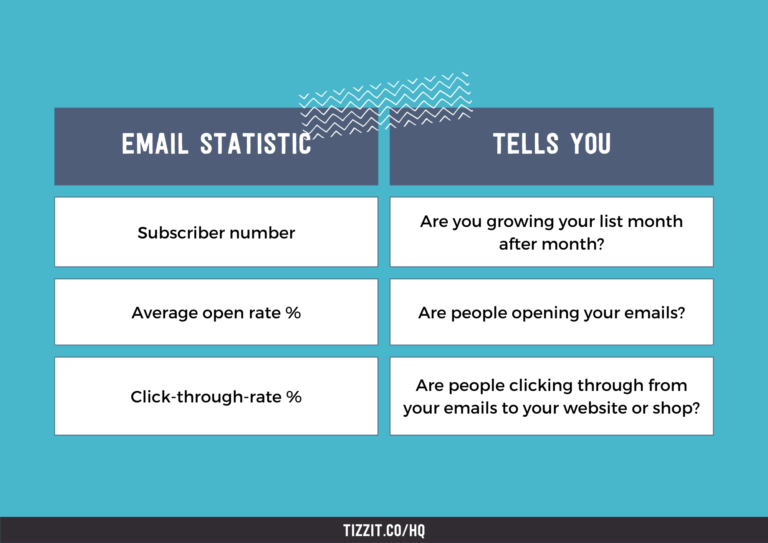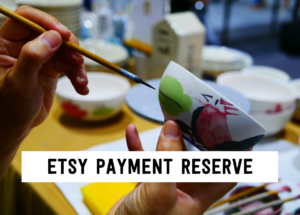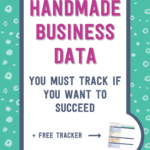
How to find the best Etsy keywords in 3 simple steps using Alura
If you want to be found in search results on Etsy, you need to optimize your product listing for SEO. And if you want to
join
join
I am guessing if you’ve opened a handmade shop, it’s because you’re creative and talented and love love love spending time coming up with new product ideas or making products and new designs.
But one part of owning a handmade shop that you may not love all that much is tracking data for your shop and keeping an eye on your analytics so you can make smart business decisions.
I know it can be a bit overwhelming when you are trying to figure out what numbers to track and how to use that information. . . so today we’re going to break it down into a very easy process – easy to understand, easy to implement, and very very valuable for your business!
I’ll tell you exactly what numbers you should track – and why – AND I even have a free stat tracker template for you to make it that extra bit easier!
So, ready? Let’s dive in.
Before we start and tell you exactly what to track, here are a few key rules that I want you to keep in mind.
First, there isn’t ONE perfect template for tracking data in your business.
Each business is different and will need different details tracked. You can start with a template but always modify it to fit your business.
I created a free template for you to use that is a great place to start – everything I’ll cover today will be ready for you in that template so you will want to download it after reading the whole article!
[free] get your handmade BUSINESS STATS TRACKER!
Use this free template to track your most important handmade business stats and grow your shop!
The second rule is to only track things you can “action.”
Data is nothing if you can’t turn it into an insight and then turn that insight into an action. So before adding anything to your tracker, ask yourself:
“Will I be able to use this information to make changes? Does this give me something I can actually work on? Or is it just data for data’s sake?”
If it’s data for data’s sake, remove it and stop tracking it. It’s not helpful.
My third rule is to not track too many things.
You don’t need to track a whole lot, no need for a crazy overwhelming spreadsheet or dashboard. The more there is, the more overwhelmed you’ll be looking at it and the less you’ll use it to take action.
The things you track at the business level should be a high level indicator that tells you if something needs more investigation. You don’t need to track smaller details because your high level indicators will tell you all that you need to know.
I’ll give you a few examples of what I mean by that later in this article but for now remember: less is more!
Okay, now that we’ve talked about those rules, let’s get into the best details to track for your handmade shop!
As you will see in your free template once you download it, there are four areas that you need to track data for:
Let’s talk in a bit more detail about each one.
The first thing you need to track is the most obvious, and that’s money.
This is the #1 thing you should be tracking, you will want to track both total orders and total sales revenue.
Total orders is the number of orders you made in the specified time period, while
Total sales revenue is how much money you earned from those orders.
The two numbers give you slightly different insights. Look at details like:
For example, let’s say you make soap. If you make $1000 from 100 sales one month, then $1000 but from 50 sales the following month, your “average order value” has gone up a lot.
That tells you that people spent more per order on average, which is good!
You also want to break these numbers down per channel if you sell via more than one channel. For example, some of you may sell your products on a combination of your own website, Etsy, markets or live events, and wholesale.
Look at the sales and revenue for each one separately, this way you can quickly see how each channel is performing.
The next detail you need to track is traffic. . . and the statistic you want to focus on is where people are finding you and your shop or website.
You want to break this down by platform, but be careful because NOT all metrics are needed here.
This is the “too many details” rule we talked about earlier. For example, say you use Instagram for marketing your shop. You don’t actually really need to know how many followers you have each month, your exact engagement rate, how many times people liked your post on average, etc. That’s overkill. If you want to create an Instagram-special tracker for that be my guest, but when it comes to your business-overview metrics, that’s way too much information.
So what’s the most important metric?
How many people CLICKED away from Instagram and ONTO your website or shop. That’s what you really want to know: how many people have found you thanks to Instagram (for example) and visited your shop from there?
The same is true for every platform.
So each month you will record the traffic (also called click-throughs) that comes to your site from each of the platforms you’re using. In our template, you’ll find a line for
These numbers give you the “key” data that you need, and you can then decide to investigate a little more based on that.
For example, you might see in your dashboard that your Pinterest or Instagram traffic has decreased, you then know to look inside your Pinterest or Instagram stats for more details as to why this could be. Look for details that might explain the change: Did you post less? Did you post differently? Did your engagement drop? Etc.
So you would use these lower level details when investigating a change in your higher level numbers, but you don’t need to track these details in your high-level dashboard.
Knowing which platforms bring the most traffic is also helpful if you decide to use paid ads— you are able to see which platforms you get a lot of clicks from that would be good places to run ads.
Next let’s move on to #3, which is tracking behavior!
When you track behavior, you are answering the question “Once people get to your shop or website, what are they doing? What’s their “behavior?” Are they staying around for a while? Are they buying your products?
Answering these questions will help you optimize for more sales, which is very important!!
For each online selling channel you are using, you’ll want to track the “big 3”:
Quick note: Understanding Visitors vs. Views
Let me quickly touch on the difference between these two terms. Although they sound similar, they tell you different things: a visitor is 1 person that came to your site – regardless of how many pages they clicked on, while a view is one person looking at one specific page.
So if you have 20 visitors and 50 views this means that on average each person has clicked on 2.5 pages or listings. This tells you how engaging your website or shop is,— do people enjoy it and look around, or do they land then leave?
As you can see, both #2 and #3 involve tracking numbers and doing analytics. If you are new to analytics or find them a bit overwhelming we have a great Google Analytics HQ course that makes Google Analytics easy to understand and track for your shop (be it on your own website OR on Etsy), be sure to check it out!
Finally, let’s talk a bit about tracking email marketing.
I like to think of email marketing as the “engine” of your marketing strategy. I’ve got an article about Craft Business Email Marketing Basics and we also have a great in-depth course inside Tizzit HQ called Email Marketing Mastery For Your Handmade Shop so definitely check both of those out— but the short summary of email marketing is that people coming to your shop or website from ANY traffic source (Pinterest, Instagram, SEO, etc.) should in a perfect world do one of 2 things: 1) buy your products or 2) subscribe to your email list.
Getting them to subscribe to your email list allows you to sell to them via email marketing if they didn’t purchase on their initial visit (which the majority of visitors won’t). So you want to have a “email stats at a glance” section in your tracker with the following information:

Now that you have the information you need to get started tracking important shop stats, you can download your spreadsheet and customize it for your shop!
Go ahead and add or remove lines as much as you see fit – keeping in mind the rules we talked about at the beginning of this article – and create your own perfect handmade shop stats tracker.
Just click the link below to download your free tracking spreadsheet and get started!
[free] get your handmade BUSINESS STATS TRACKER!
Use this free template to track your most important handmade business stats and grow your shop!
Thanks for reading, and until next time, au revoir!
you might also like…
related articles

If you want to be found in search results on Etsy, you need to optimize your product listing for SEO. And if you want to

There has been a lot of talk in the Etsy community — and I mean A LOT of talk — about Etsy’s payment account reserve

Anyone who knows me knows that I am a HUGE advocate for using email marketing to grow and scale your handmade business. But you may
disclaimer
subscribe to youtube
THE LAUNCHPAD
get in touch
We acknowledge and give thanks to the Budawang and Yuin people, the Traditional Owners of the land we work and live on. We pay our respects to all Aboriginal and Torres Strait Islander Peoples and elders past, present and emerging.

Grab this free
handmade business
stats tracker